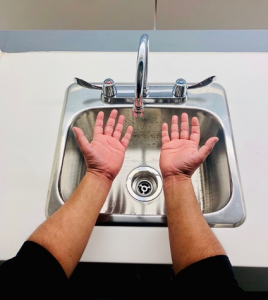Hand Washing with Soap and Water
Hand washing involves the use of soap and water to physically remove microorganisms from your hands. Certain occasions will require hand washing instead of relying on ABHR. You must wash your hands with soap and water if your hands are visibly soiled, have been exposed to any blood or body fluids, or have been exposed to or suspected to have norovirus or C. difficile or Bacillus anthracis (PIDAC, 2012; PIDAC, 2014). The mechanical action of lathering and scrubbing with soap for a minimum of 20 seconds while washing your hands is important to remove transient flora and bacteria.
Hand hygiene with water requires soap to dissolve fatty materials and facilitate their subsequent flushing and rinsing with water. Soap must be rubbed on all surfaces of both hands followed by thorough rinsing and drying. Water alone is not suitable for cleaning soiled hands (PIDAC, 2014). The entire procedure should last 40 to 60 seconds and use a soap approved by the health agency.
Hand Hygiene with Soap and Water
Steps |
Additional Information |
1. Inspect hands for open cuts or wounds, and cuticle for tears.Open cuts or wounds can harbour microorganisms and should be covered prior to starting client care.Nails should be short, with no nail polish or acrylic nails. |
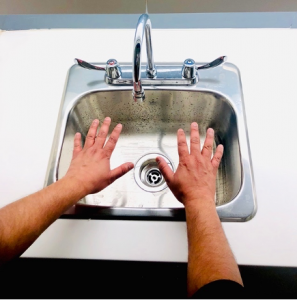
|
2. Remove all jewellery.No rings or bracelets. Watches should be pushed above the wrist or removed.Push long sleeves above wrists.Make sure your hair is up and off your shoulders.Secure headwear (e.g., hijab, kipper, turban, taqiyah) to your head and tuck in any excess material into your uniform to avoid contamination. |
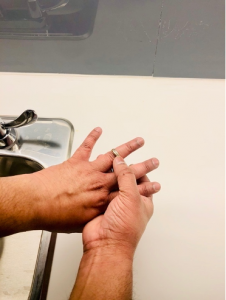 |
3. Position yourself in front of the sink.Stand in front of the sink, keeping your hands and clothing away and off the sink surface. |
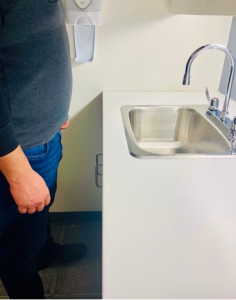 |
4. Wet hands and wrists with warm water.A comfortable temperature of warm water should be used. Hot or cold water may damage skin and lead to dryness.Adjust water to a medium flow. Too slow may not remove debris, and too fast can cause splashing of microorganisms onto your clothing and sink area.Wet hands and wrists thoroughly under running water. |
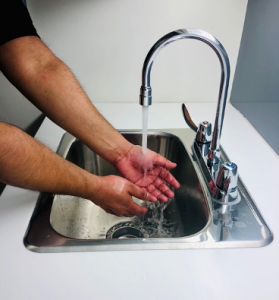 |
5. Apply 1 to 2 pumps of soap.Enough soap should be used to cover both hands and wrist. Create a lather on the palms, back of hands, fingers, thumbs, and wrists. |
 |
6. Lather soap and rub palms together.Ensure all surfaces of the palms are covered with soap, using friction to lather all surface areas for a minimum of 20 seconds to remove transient bacteria, debris, and oil.Keep hands and forearms lower than elbows to facilitate the removal of microorganisms by running down and off your hands and into the sink. |
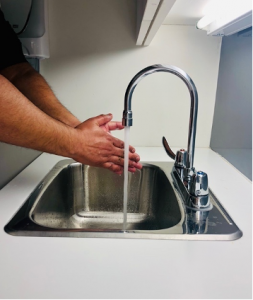 |
7. Rub in between fingers and around fingers.Ensure all surfaces of the fingers are covered with soap, using friction to remove debris and oil. |
 |
8. Rub the back of each hand with the palm of the opposite hand.Ensure all surfaces on the back of the hands are covered with soap, using friction to remove debris and oil. |
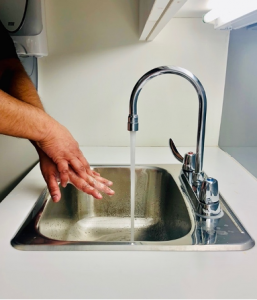 |
9. Press and rub fingernails and fingertips into the palm of the opposite hand.Ensure all surfaces around the fingertips are covered with soap and rub under each fingernail bed by rubbing into the palms, using friction to remove debris and oil. |
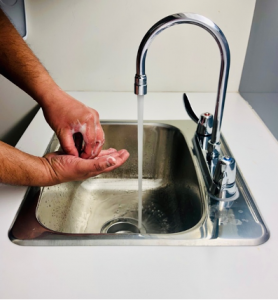 |
10. Rub each thumb in a circle with the palm of the opposite hand.Ensure all surfaces around the thumbs are covered with soap, up to the wrist and around wrists, using friction to remove debris and oil. |
 |
11. Rinse hands under water by keeping fingers pointing downward toward the drain.Rinsing in this way allows the oil and debris to be washed off the hands and down the drain.Thoroughly rinse hands to remove soap. Any soap that remains on the hands can lead to dryness or breakdown in skin integrity. |
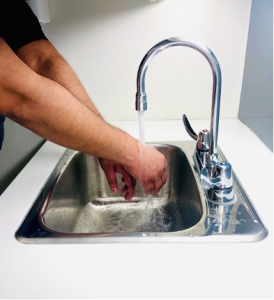 |
12. Pat hands thoroughly dry using a clean paper towel.Use a gentle action to prevent skin irritation. Dry hands from fingertips to wrists in one direction to prevent re-contamination. |
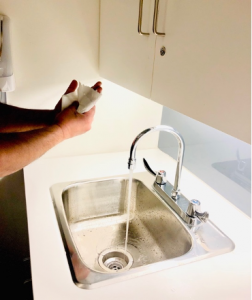 |
13. Using a new clean paper towel, turn off the faucet.Using a new paper towel prevents re-contamination of hands by touching dirty faucet handles. |
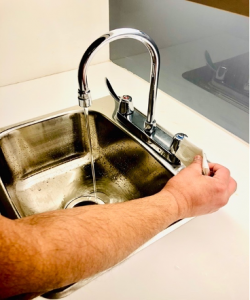 |
14. Assess hands to ensure all soiled areas are clean. Hands are now safe to use. |
 |
Source: PIDAC, 2012; PIDAC, 2014. |
Points of Consideration: Hand Hygiene and No Running Water
If hands are visibly soiled and there is no running water available, a moistened cloth or towelette can be used to wipe away the soiled area, followed by the use of an ABHR.
Safety Considerations
- Always wash hands with soap and water if hands are visibly soiled.
- When working with clients where C. difficile, norovirus, or Bacillus anthracisis suspected or confirmed, soap and water must be used because it is more effective at physically removing the C. difficile spores compared to ABHR, which is not as effective as penetrating the spores (PIDAC, 2014).
- Friction and rubbing are required to remove transient bacteria, oil, and debris from hands.
- Always use soap and water if hands are exposed to blood, body fluids, or other body substances.
- Multi-step rubbing techniques using soap and water are required to promote coverage of all surfaces on hands.
Common Errors when Washing Hands with Soap and Water
- Not using enough soap to cover all surfaces of the hands and wrists.
- Not using friction when washing hands.
- Not washing hands long enough. Should be a minimum of 20 seconds (PIDAC, 2012).
- Skipping steps (e.g., fingernails, wrists, back of hands, thumbs).
- Not removing all soap from hands and wrists.
- Shaking water off your hands.
- Not thoroughly drying your hands.
- Drying your hands from wrists to fingers or in both directions.
Points of Consideration: Paper Towels vs. Hot-Air Dryers
After washing your hands with soap and water, use paper towels to dry your hands. Dry your hands from your fingertips to your wrists in one direction until your hands are thoroughly dried.
Drying your hands with paper towels provides the lowest risk of cross-contamination compared to hot-air dryers (PIDAC, 2014). It is important to ensure hands and wrists are thoroughly dried because moisture can harbor microorganisms. Using paper towels decreases the chance of moisture remaining on your hands (PIDAC, 2014).
Hot-air dryers can disperse and spread microorganisms that are on the hands and should not be used in clinical settings (PIDAC, 2014).
Test Yourself!
While watching the interactive video on handwashing with soap and water, apply what you have learned by answering the questions throughout the video. Please note: there is no sound in this video.
Watch the following video demonstrating and explaining how to perform hand hygiene with soap and water.
Clinical Tip
As a healthcare provider, you will perform hand hygiene numerous times each shift. Continuously performing hand hygiene can impact the integrity of your skin. It is important to take care of your skin to avoid any skin breakdown, irritation, or lesions. Ask your healthcare facility or occupational health team about the facility’s hand-care program to learn about various techniques to protect your hands. For example, the importance of wearing gloves in colder weather, the rationale for removing jewellery when providing care, or when to use facility approved hand-care lotions at work. Public Health Ontario Just Clean Your Hands Hand Care Program document outlines key strategies to help you protect your hands: https://www.publichealthontario.ca/-/media/documents/J/2009/jcyh-hand-care-program.pdf?la=en
Test your Knowledge
Attribution
Infection Prevention and Control Practices by Michelle Hughes and Kendra Allen is licensed under a Creative Commons Attribution 4.0 International License, except where otherwise noted.

